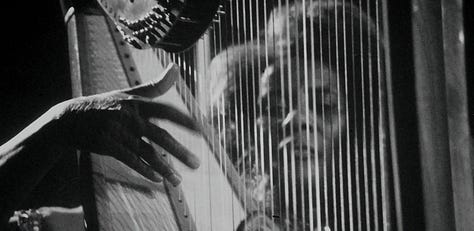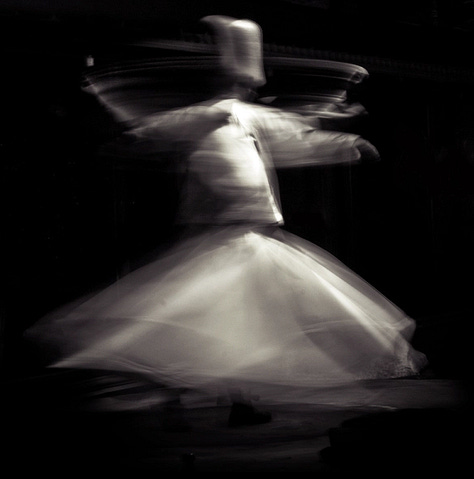What does it mean to write about womanhood without reducing it to flesh?
To render sensuality without performance, and speak of the erotic without spectacle? Inspired by Rumi’s spiritual longing, Sappho’s lyrical desire, Anaïs Nin’s intimate introspection, the quiet mysticism of Alice Coltrane, the shadowy softness of Sarah Moon’s photography, and W.S. Merwin’s restrained grace, this essay explores the quiet resonance of womanhood- a kind of music made not of exposure, but of breath, memory, and presence. Feeling.
06.17.25 Los Angeles, 6:11 a.m.
There’s a way to speak of womanhood that skips the obvious curves and lands straight on the pulse. Like a muted trumpet in a dark club- warm, unsaid. I lean into that space: the suspended breath before the note, the charged hush before a body becomes flesh in language. Womanhood is not a terrain you conquer. It’s a melody you learn to whistle without words.
Let the beauty you love be what you do. ~Rumi
That beauty, I’ve discovered, lives in the undercurrent- how light lingers on collarbones at dusk, how velvet mornings brush against the skin like a question unanswered, how the sheets have left dents on your cheeks from a restless night. To write the erotic without sounding obscene is to hold back more than you release.
It’s Sappho’s art: “sweet apple-blossoms,” “immortal Aphrodite,” yet never once a direct gaze at thighs or limbs- only invocation. Only the electricity of longing.
Jazz teaches the same discipline. The saxophone doesn’t blare. It sighs. It curves off a note, carves the space, and leaves it hanging.
And then there’s Alice- plucking spirit from the harp, letting holiness ride the drone. Her notes don’t resolve. They hover like incense, like longing that doesn’t beg to be named.
Womanhood doesn’t take up space; instead, womanhood communes with it- like a note sustained so long it becomes the room.
“I feel my heart quietly undone by the slow stroke of a morning light.” ~Anaïs Nin
Nin never gives you the mechanics of bodies. She gives you the nervous system of feeling and Womanhood is that nervous system.
It is the slide of skin into new book pages at dawn, the secret thrill that something old can still surprise you- that something so known, so worn by time, still has glimmer, that something so familiar, so lived-in, can suddenly open itself to bloom and leave you in awe.
This isn’t the body’s hunger. It’s form and formlessness. It smells like basil in a glass of iced water, a hand resting at the curve of a hip, not touching- simply being, connected by gravity. It is the “Wish” when he said:
Please one more
kiss in the kitchen
before we turn the lights off ~W.S. Merwin
Merwin writes this without punctuation, without pause or finality. This absence transforms the poem into a breath held indefinitely, a moment that refuses to close. He leaves the words unmarked, and he invites you into a lingering space where time dissolves. It is not just a kiss before darkness; it is the echo of that kiss stretching into the infinite, the quiet afterglow that refuses to be contained.
Sarah Moon reminds us that beauty is found in what remains unseen, in the shadow and the blur, in the unfinished.
Intimacy lives not in the act alone, but in the silence and the memory that follow- resonating endlessly, like a note that refuses to fade.
Desire could be a lyric, not a transaction. Spirit could be sensuality- not separate from flesh, but inseparable. Improvisation could be embodiment- if you bend, if you lean, if you pause. Intimacy is the geometry of the invisible: a mapping of currents, not a drawing of outlines.
So here I write- not about what a woman does or wears or says, but about the way she carries the silence that can unstring a room without a syllable. About how she can be two notes at once- dissonance and resolution, longing and arrival- and never be trite.
Womanhood, in this sense, is a track we spin in private. It is the space between notes where identity dwells. It is the gathering of all the untranslatable vital moments- a chord you feel in your chest before your mind knows what you’re hearing.
This essay is a summons to that space. It’s an invitation to unlearn the script that says sensuality equals exposure. I am learning to reclaim it as resonance: a vibration inside, unadvertised, powerful, and quietly known.
Author’s Note:
This piece is part of an ongoing practice in self-examination. It is a meditation on embodiment, jazz, poetry, art, and womanhood. Lately, I’ve been writing in pursuit of the invisible frequencies- the places where language, feeling, and memory intersect. Thank you for reading. If it resonates, I’d love to hear from you.









